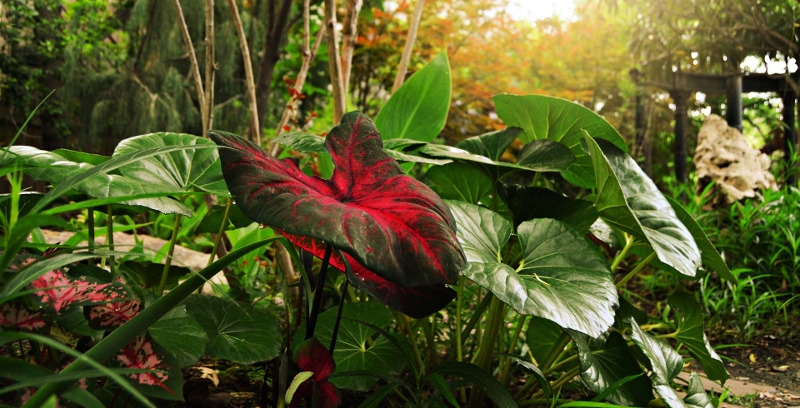With their painted, shield-like leaves, caladiums are the tropical showboats of the shady garden. They come in variegated, stippled, and striped pinks, whites, reds, and purples in almost every combination. They share the nickname “elephant ear” with their cousins the Alocasias and Colocasias. Indoors or out, they are seasonal tuberous plants that go dormant in the fall, but the longer and hotter your growing season, the more time you’ll enjoy admiring these dramatic plants.
In the Araceae family, they are poisonous to both animals and humans if ingested, and sap from the leaves and stems can cause mild skin irritation. Hardy from USDA zones 9-11, they are often grown as annuals, or brought inside potted while dormant or to store the tuber.

Planting Caladiums
Bought as tubers in spring, the largest size (Jumbo) tuber will give you the biggest jumpstart for a short-season garden. They can be planted once temperatures are reliably over 60 degrees outside even at night – typically three weeks after the last frost date. Some new varieties can tolerate full sun, but most thrive in filtered sun or light shade, which can intensify the leaf colors. Avoid windy spots to protect the large leaves. Container planting can help speed growth in colder climates since the ground heats up faster.
Whether in-ground or potted, well-drained soil rich in organic matter is ideal. Tubers should be planted with the growth tip up and about 1 ½-2 inches below the surface, and about 10 inches apart, depending on the variety’s mature size. If buying pre-potted caladiums, they may need to be acclimated to midday outdoor conditions over several days in your garden before staying out overnight.
Watering Caladiums
Caladiums have large tubers that retain water, making them sensitive to overwatering. The goal is to find the sweet spot of even moisture – almost allowing the soil to dry but not quite. If the leaves are yellowing and dropping that can indicate it’s too dry. Applying mulch around the crown (not the stalk) of the plant will help keep moisture levels even.

Fertilizing Caladiums
For caladiums, a little fertilizer goes a long way. In fact, too much can burn the leaves, giving a scorched appearance. Some experts recommend using a slow-release or liquid fertilizer diluted to ¼ the strength recommended on the product instructions.
Pruning Caladiums
Caladiums need little pruning. If you see the plant becoming rangy or you’d like to encourage thicker, bushier growth you can pinch off the growing tips. This can be done any time during the growing season but will yield best results early on. Flowers are best removed to reserve the plant’s energy for those amazing leaves. When the foliage dies back in fall, clear it away and decide, based on your climate, if you will store/grow the plant inside, or compost and replace in spring.
Caring For Caladiums in Pots
If you are planting a tuber, select a pot that allows at least 8-10” across and deep, depending on the size of the variety at maturity. Plant the tuber with the growing side up (wide base down, like an onion) so that the tip is scarcely 2” deep. Use a high-quality, well-drained potting mix with plenty of organic matter to support growth.
Keep the soil about the texture of a wrung-out sponge without fully drying out. Watch for wilting or yellowing leaves which can mean dry soil. Mulching the soil will help retain moisture.

Winter Care for Caladiums
In zones 9-11, caladiums can be perennial, and can be left in the ground or in containers, well mulched. The leaves will die down in the fall, at which point, watering should be reduced. In colder zones, gently dig out the tuber and store in a dark dry spot at least 65 degrees F in sand, sawdust, or vermiculite, or pot it and grow as a houseplant. Tubers can be divided before planting out in spring.
Growing Caladiums Indoors
Caladiums like it hot – no less than 65 degrees F – and steamy. They prefer the high humidity conditions found in bathrooms, sunrooms, and greenhouses – provided there is at least four hours of filtered sunlight. Avoid places with temperature fluctuations like drafty windows or next to a heater. Keep your plant’s soil evenly moist until it goes dormant in the fall and the leaves die back. When new leaves emerge, resume regular watering. Keep away from children and pets, as all parts are toxic.
Caladiums For Sale
Common Caladium Care Questions
Can Caladium Grow In Water?
Caladium can be grown in water, but be sure to use non-chlorinated water and change the water once a week or when the water becomes discolored. It will also be necessary to feed them with a water-soluble fertilizer since they'll not be getting nutrients from the soil. Be careful not to put them in a window where they'll get too hot., they'll need partial to full shade so they don't burn.
Do Caladiums Need Sun Or Shade?
Caladiums can do well in full sun to full shade, but they prefer the soil to be warm and moist.
Do Caladiums Come Back Year After Year?
Caladiums are grown from bulbs and in zones 9 and higher, may come back however they are considered to be short-lived perennials, and cannot survive cold temperatures, so are most often grown as annuals. However, they make great houseplants and can be brought indoors!
Where Do Caladiums Grow Best?
Caladiums do best in part shade to part sun (4-6 hours of direct sunlight, preferably morning sun) or dappled shade. Though there are a few varieties that do well in full sun, generally speaking, they should be protected from the sun's rays during the hottest part of the afternoon.
Why Are My Caladium Leaves Small?
Small leaves on caladiums are likely a combination of issues, either under- or over-watering, too much direct sunlight, and temperatures that are not warm enough.
Do Caladiums Spread?
Caladiums are tubers and can spread, but also be divided and transplanted. Dividing them will help them to rejuvenate.
Are Caladiums Invasive?
Caladiums are not invasive.
Are Caladiums Drought Tolerant?
Caladiums prefer consistently evenly moist soil and need to be watered on a regular basis, weekly at least, perhaps more during extreme heat. Caladiums in containers should have the soil checked daily.
Have a question about Caladiums? Fill out the form below and we will try and get back to your question as soon as possible. We may even feature your question on this article to help other gardeners!
 |
Author Erica Browne Grivas - Published 08-10-2021 |
